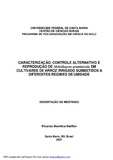| dc.creator | Steffen, Ricardo Bemfica | |
| dc.date.accessioned | 2017-04-10 | |
| dc.date.available | 2017-04-10 | |
| dc.date.issued | 2007-02-22 | |
| dc.identifier.citation | STEFFEN, Ricardo Bemfica. Characterization, alternative control and reproduction of Meloidogyne graminicola in cultivars of irrigated rice to different regimes of humidity. 2007. 96 f. Dissertação (Mestrado em Agronomia) - Universidade Federal de Santa Maria, Santa Maria, 2007. | por |
| dc.identifier.uri | http://repositorio.ufsm.br/handle/1/5567 | |
| dc.description.abstract | The rice is one of the cereals more cultivated in the world, however its production can be limited by several plant pathogenics agents, among them the rootknot nematode (Meloidogyne spp.). The present work was accomplished in three stages. In the first, twenty and one populations of root-knot nematode of eight districts of the central area of Rio Grande do Sul State, were biochemical characterized through the isoenzyme esterase and morphological characterized through the microscopic observations of nematode females perineal patterns. In the second stage of the work, they were appraised the penetration and the development of M. graminicola in the roots of the irrigated rice (BR-IRGA 410, IRGA 417, IRGA 420, IRGA 422CL, BRS 7 "Taim", BRS Atalanta, BRS Fronteira, BRS Firmeza, BRS Pelota and BRS Querência) cultivars recommended for the South of Brazil, as well as the reaction of these materials to the nematode. In the third stage of the work the effect of ten essential oils of bioactives plants were evaluated in the control of M. graminicola "in vitro", as well as the efficiency essential oils in the control of the irrigated rice plant nematode. The isoenzymatic characterization of root-knot nematode in the area studied revealed the presence of the phenotype esterase VS1 (Rm 0,70), typical of M. graminicola. Among the cultivars tested, most were independently susceptible of the irrigation regime. The cultivar IRGA 422CL was what provided a smalest penetration of nematodes for the evaluated conditions
behaving as moderately resistant under condition of saturation of soil. The oregano, eucalyptus and mint oils presented the highest nematostatic effect "in vitro ", while the alfazema, cidrão and alecrim oils presented highest effect nematicida "in vitro" also reducing the multiplication of nematode "in vivo", demonstrating its potential in the control of M. graminicola. | eng |
| dc.description.sponsorship | Coordenação de Aperfeiçoamento de Pessoal de Nível Superior | |
| dc.format | application/pdf | por |
| dc.language | por | por |
| dc.publisher | Universidade Federal de Santa Maria | por |
| dc.rights | Acesso Aberto | por |
| dc.subject | Nematóide das galhas | por |
| dc.subject | Ocorrência | por |
| dc.subject | Identificação | por |
| dc.subject | Esterase | por |
| dc.subject | Resistência | por |
| dc.subject | Oryza sativa L. | por |
| dc.subject | Root-knot nematode | eng |
| dc.subject | Occurrence | eng |
| dc.subject | Identification | eng |
| dc.subject | Esterase | eng |
| dc.subject | Resistance | eng |
| dc.title | Caracterização, controle alternativo e reprodução de Meloidogyne graminicola em cultivares de arroz irrigado submetidos a diferentes regimes de umidade | por |
| dc.title.alternative | Characterization, alternative control and reproduction of Meloidogyne graminicola in cultivars of irrigated rice to different regimes of humidity | eng |
| dc.type | Dissertação | por |
| dc.description.resumo | O arroz é um dos cereais mais cultivados no mundo, entretanto sua produção pode ser limitada por vários agentes fitopatogênicos, dentre eles o nematóide das galhas (Meloidogyne spp.). O presente trabalho foi realizado em três etapas. Na primeira, vinte e uma populações do nematóide das galhas provenientes de oito municípios da região central do Estado do Rio Grande do Sul foram caracterizadas
bioquimicamente através da isoenzima esterase e morfologicamente através de observações microscópicas de configurações perineais das fêmeas do nematóide. Na segunda etapa do trabalho, foram avaliados a penetração e os estádios de desenvolvimento de M. graminicola nas raízes dos cultivares de arroz irrigado (BRIRGA-410, IRGA-417, IRGA-420, IRGA-422CL, BRS 7- Taim , BRS Atalanta, BRS Fronteira, BRS Firmeza, BRS Pelota e BRS Querência) recomendados para o Sul do Brasil, bem como a reação destes materiais ao nematóide. Na terceira etapa do trabalho foi avaliado o efeito de dez óleos essenciais de plantas bioativas no controle de M. graminicola in vitro , bem como a eficiência dos óleos ssenciais no controle do nematóide em plantas de arroz irrigado. A caracterização isoenzimática do nematóide das galhas na região de estudo revelou apenas a presença do fenótipo esterástico VS1 (Rm 0,70), típico de M. graminicola. Dentre os cultivares testados, a maioria foi suscetível independentemente do regime de irrigação. Apenas o cultivar
IRGA-422CL foi o que proporcionou uma menor penetração dos nematóides para as condições avaliadas, comportando-se como moderadamente resistente sob condição de saturação do solo. Os óleos de orégano, eucalipto e hortelã foram os
que apresentaram o maior efeito nematostático sobre os ovos de M. graminicola in vitro , enquanto que os óleos de alfazema, cidrão e alecrim além de terem apresentado maior efeito nematicida in vitro , também reduziram a multiplicação do nematóide in vivo , demonstrando seu potencial no controle do nematóide. | por |
| dc.contributor.advisor1 | Antoniolli, Zaida Ines | |
| dc.contributor.advisor1Lattes | http://lattes.cnpq.br/4692942549618168 | por |
| dc.contributor.referee1 | Gomes, Cesar Bauer | |
| dc.contributor.referee1Lattes | http://lattes.cnpq.br/3411662870994341 | por |
| dc.contributor.referee2 | Muniz, Marlove Fátima Brião | |
| dc.contributor.referee2Lattes | http://lattes.cnpq.br/3148312031889388 | por |
| dc.creator.Lattes | http://lattes.cnpq.br/7961564880063872 | por |
| dc.publisher.country | BR | por |
| dc.publisher.department | Agronomia | por |
| dc.publisher.initials | UFSM | por |
| dc.publisher.program | Programa de Pós-Graduação em Ciência do Solo | por |
| dc.subject.cnpq | CNPQ::CIENCIAS AGRARIAS::AGRONOMIA::CIENCIA DO SOLO | por |


